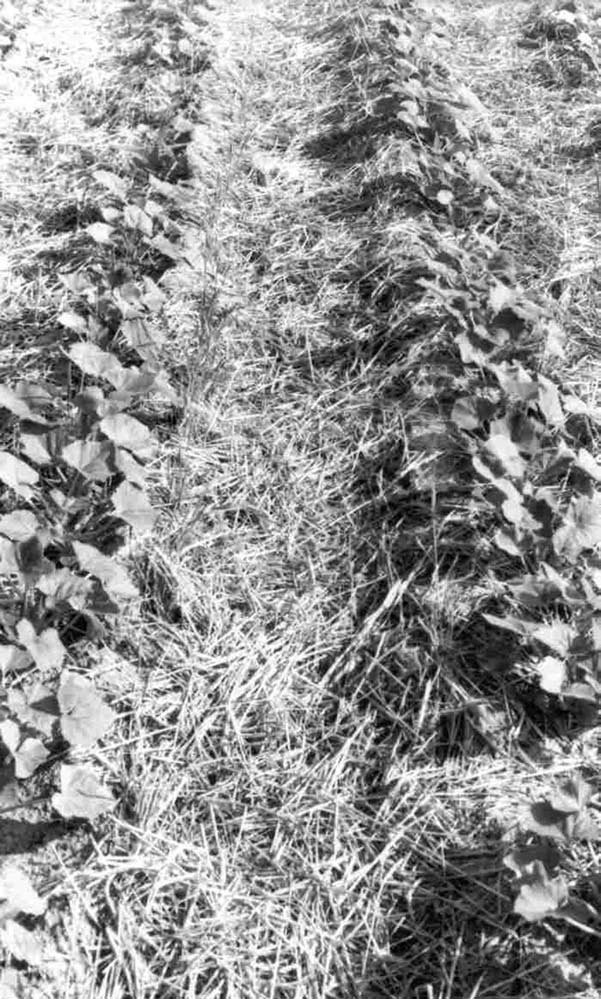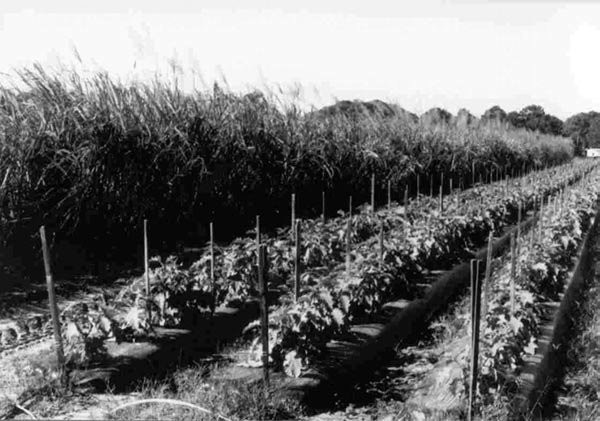Agroecology
Agroecology is the application of ecological principles to agricultural production systems and the resources needed to sustain them. A convenient unit of study is the agroecosystem, often a single agricultural field. A major difference between an agroecosystem and a natural ecosystem is in the level of human intervention and management involved. Like natural ecosystems, agroecosystems consist of living (biological) and nonliving (chemical, physical) portions. The science of agroecology examines the living organisms (collectively called the community) in the system, their interactions with one another, and the environmental factors that influence them.
Nutrient Cycling
The organisms within an ecological community depend on one another for energy and materials. Green plants are referred to as producers since they are at the base of the food chain in ecosystems. Initially, carbon and energy are stored in plant tissues through the process of photosynthesis. Consumers must obtain their carbon and energy by eating plants or other organisms. Therefore carbon and other materials move from green plants to herbivores to carnivores, including predators and parasites. The different levels of energy production and consumption (producers, herbivores, predators) are called trophic levels, although in reality many organisms do not restrict their feeding to one level. For instance, some Hymenoptera that are parasitoids as larvae may feed on pollen or nectar as adults. As a result, the paths along which materials move through the organisms in the community can be quite complicated, and collectively they make up the food web within the community.
Many nutrients, including nitrogen, phosphorus, potassium, and other elements, are essential components of plant and animal tissues. These nutrients have distinct cycles in ecosystems, and they cycle in food webs along with carbon and other materials. Nutrients are released into the soil during decomposition of organic molecules, where they are converted into forms that can be taken up by plant roots, completing the nutrient cycle. Microarthropods such as mites and springtails are particularly important in the decomposition process.
Cropping Systems
Crop performance depends on a range of key resources including nutrients, water, soils, and other environmental factors, and many agricultural management practices are aimed at optimizing and conserving these resources. Various types of cropping systems may be selected to address specific goals or conservation issues. Conservation tillage and other reduced tillage practices are important for soil conservation and reduction of erosion. The crop residues that remain on the soil surface in uncultivated sites can also aid in conservation of water and organic matter, and may provide some nutrients when they decompose (Fig. 28). Monoculture allows a grower to specialize by growing only one crop, while polyculture permits a grower to diversify by growing multiple crops on the same land. Multiple cropping on the same site may occur at the same time or over time. In the United States, the most common form of multiple cropping is crop rotation, in which different crops are grown on the same site in different seasons or years. Cover crops are crops with limited market value that are grown on the site during seasons that are unfavorable for growing the main economic crops for the region. In the southeastern United States for example, a winter cover crop of rye (Secale cereale) or crimson clover (Trifolium incarnatum) may be grown in a field reserved for cotton or peanut production during the summer. Cover crops can provide various advantages, including erosion reduction, increased supply of nitrogen, competition with weeds, or hay for animals. Green manures, which are usually legume cover crops, are grown specifically for their nitrogen-rich residues and soil fertility benefits. Intercropping, or mixed cropping (Fig. 29), refers to the growing of two or more crops at the same time on the same land. The practice is quite common in some regions, and many variations exist. Some tropical subsistence intercropping systems are especially diverse and complicated.
Pest Management
The cropping system used has a direct effect on pest management, which is an important aspect of agroecology. For example, monoculture may encourage buildup of some pests, such as corn rootworms (Diabrotica spp.) or wireworms (Elateridae), that can be managed by appropriate crop rotation. In many cases, the use of intercropping has resulted in less severe pest outbreaks and increased diversity of natural enemies compared to monocultured systems.
Tritrophic (plant-herbivore-predator) interactions and the structure of the food web may be affected by changes in the cropping system, such as use of an intercrop, or changes in crop variety or fertility level. The development and use of biologically based pest management tactics such as use of natural enemies or resistant varieties require a detailed knowledge of pest biology and ecology, including life cycle, population dynamics, and interactions with the physical and biological environment, including potential competitors, predators, and parasites. Such tactics may be directed toward preventing pest buildup rather than reacting to high pest numbers already present in crisis situations. However, the design of a system in which pest numbers are less likely to reach crisis levels, due to the presence of effective natural enemies for example, requires advanced planning based on sound ecological data.
Landscape Ecology
An individual agroecosystem does not stand alone, since organisms, materials, and energy move freely in and out of the system. Landscape ecology examines the agroecosystem in the context of the surrounding region or landscape, an essential approach in dealing with migrating insects or regulated pests. The condition of field borders, hedgerows, and adjacent fields critically affects pest management within a specific field. Movement of pesticides, fertilizers, and other potential pollutants from the agroecosystem to natural ecosystems is a major environmental concern.
Many natural ecosystems are highly dependent on recycling, since cycles of nutrients, water, and other materials tend to be relatively closed. In contrast, an agroecosystem is not a closed system, because its purpose is to produce harvest for export to other ecosystems. This process depletes essential resources from the agroecosystem which must be restored if the system is to remain productive. The movement of essential resources into the agroecosystem and the recycling of existing resources are therefore critical concerns, to anticipate and ensure that supplies of critical resources for agricultural production will be conserved over time to sustain future agricultural production.

Figure 28 Residues from a previous rye crop cover the soil surface between plant rows in this conservation tillage system

Figure 29 One of the simplest forms of intercropping is to use one crop as a windbreak, like the sugarcane planted along with the eggplant crop shown here

Agricultural Crop Pests in Southeast Asia Including Southern China


